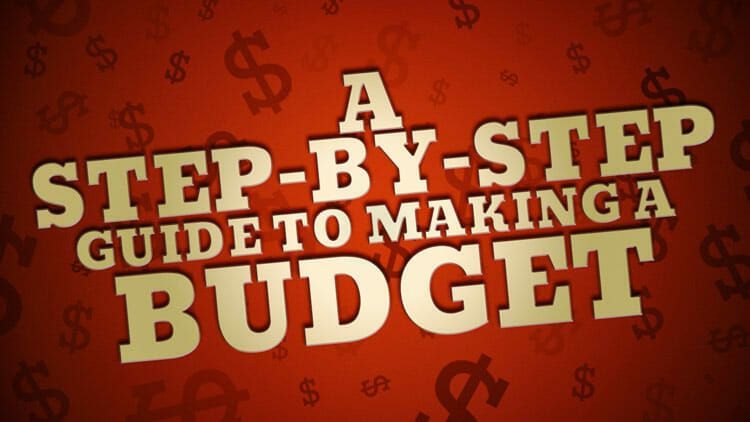You’ve probably noticed that most financial websites, books, and professionals offer the same piece of advice to anyone who wants to get their financial health in order: start budgeting.
There is a reason for this. Like it or not, budgeting works. But sometimes really sticking to a budget seems impossible.
The first step to budgeting is knowing how to budget. We will guide you through this process step by step until you feel inspired to get started.
Why Most Budgets Fail
We’ve all failed in our budget. Cars suddenly break down, there are nightly parties, and life throws you twisted balls that you can’t afford. But this is not the reason for the failure of budgets.
Budgets tend to fail for two reasons:
- They don’t track spending habits accurately
- They lack well-defined, achievable goals
In other words, if your budget isn’t accurate and doesn’t seem important to you, it won’t work.
Keep reading for detailed instructions on how to create a budget that you can stick to.
Step 1. Choose a budgeting method
Luckily for those who have ever struggled with budgeting, there are hundreds of different budgeting methods. From apps to magazines to simple spreadsheets, there’s a method for you. Here are some of the best for beginners.
50-30-20
If you are relatively stable financially with a stable income and predictable bills, this budget is for you.
The 50/30/20 budgeting method is simple. You spend:
- 50% of your income for living expenses (including fixed monthly expenses such as car payments, rent and mortgage payments, and variable expenses such as groceries and gasoline)
- 30% of your income from desires and lifestyle choices (entertainment, entertainment, dining out, etc.)
- 20% of your income to pay off debt and savings (for example, your reserve fund)
If you don’t have a regular cash flow, this system can be difficult to implement. That is why we recommend this method for stable earnings.
Any of these budget categories can change depending on a variety of factors. For example, if you have $100,000 in student loans, auto loans, medical bills, and a couple of credit cards, you will end up using more than 20% of your income to pay off debt. And if you’re on a low starting salary and live in New York (or any other major city, for the most part), you’ll probably be spending more than 50% of your income on living expenses.
If you want to use this method, adjust the percentages as needed to make it work for you.
Read more: Why you’re living beyond your means – and you don’t even know it
Spreadsheet
Using a spreadsheet can help you keep track of your spending and stay on top of your money. And we have a great version that is free to use.
Our spending plan template includes categories for all your monthly expenses from your recurring bills to your debt payments and the ways you want spend money. It follows the 50/30/20 budgeting method we just mentioned, but does all the work of calculating how much you can spend in each budget category and subtracting expenses as you add them.
Using your actual income, especially your net income after taxes, it breaks down your spending into needs, wants, and financial goals. You enter all your expenses and payments and the spreadsheet will do the rest.
Click on the link below to get our budget table.
Read more: Free Monthly Budget Template for Google Sheets
Bullet magazine
bullet journal budgeting it is a form of pencil and paper budgeting that can be especially helpful in keeping track of your spending.
When you actively participate in your budget and see it written and drawn in front of you, you may be more inclined to stick to it.
With a bullet journal, you manually record every time you spend money. It can be tedious, but it’s worth it. This will help you see exactly where your money is going without leaving room for guesswork, and may be ideal for you if discipline is your biggest problem with budgeting.
Programs
Technology can be a big help when you’re getting started with a budget. There are many great budgeting apps there for whatever type of method or system you’re looking for, so you can try a few strategies until you find one that clicks. Here are some of our favorites and what sets them apart.
You need a budget (YNAB) – This budgeting app uses a zero-based budgeting system, which means that every dollar of your monthly income has a purpose in your personal budget, be it spending, savings, or anything else. This allows you to link your bank account so you don’t have to manually add transactions. YANAB ideal for proactive, hands-on budgeting and saving money.
personal capital This money management app goes beyond budgeting. You can also use it to track your net worth, monitor your investment portfolio, plan for retirement, and more. Tools like the Monthly Budget Calculator help you organize your variable and fixed expenses to make room for your financial goals.
Step 2: Track your expenses
One of the reasons most of us never manage to stick to a budget is because we like to believe that we have more control over our money than we actually do. In other words, we underestimate how much we spend. To create a budget, you need to start by tracking your money for a month. It will show you how you Really spend money.
Recurring expenses such as rent, insurance, and internet are fairly easy to budget, but variable and unexpected expenses are harder to keep track of. You can record most of them by reviewing credit card statements and bank statements.
If you don’t like what you find and you find yourself overspending, take a few small steps right now. See how little you can spend on food and not go crazy eating pasta every night. Find out what expenses you can cut – can you live without Netflix? With a cheaper place for a phone? Can I use public transport instead of a car? You receive a picture.
Read more: How to save quickly
Step 3. Write your budget
Since it took you a month to see how much you were really spending, you should have a good place to sit down and write down your budget or enter some numbers into the app.
Write down your income
If you have a stable income, here’s how to find out how much you really earn and what figure to use to earn.
- If you are paid bi-weekly, multiply your salary by 2.166 to find your monthly income.
- If you are paid weekly, multiply your salary by 4.333.
If you variable income budgetingFollow these steps.
- Open another savings account for money to cover occasional expenses and set aside the same amount each month.
- Pay yourself every two weeks or monthly if you can to ensure you have a regular income.
Record your expenses
It’s better to reevaluate your expenses to give yourself some wiggle room. Create categories that never change for fixed expenses, and be sure to include variable expenses such as savings, eating out, emergencies, and repairs.
Think about your weekly, monthly and yearly expenses. The more specific you are and the further you think about the coming year (like Christmas gifts and car registration), the better.
Use the same method to pay bills every month
You can use an app, credit card, debit card, or other bill payment method. It depends on what you are comfortable with and what you are most likely to remember. For most payment methods, you can turn on automatic payments at make sure you don’t miss a payment and save money on late fees.
Step 4: Keep track of your budget (and set a goal)
Obviously none of this matters if you don’t actually follow your budget. But to stay motivated, you need to set goals. Think about your financial picture as a whole: what could you do with the extra money you have when you get your spending under control?
Are you saving money for a down payment on a house? Hope for buy a car? Work on get out of debt? Make sure your goal is important to you. This will help you stay on budget.
Read more: Budgeting at 20: why and where to start
Step 5: Adjust to real life
No matter how well you stick to your budget, if unexpected expenses come up and you don’t have savings, you’re in trouble. There are several ways to include unexpected expenses or income in your budget.
Our number one tip is to create emergency fund – a separate savings system that you use only in emergency cases. If you live paycheck to paycheck, this can be difficult to do. But if you save anythingno matter how small, you are on the right track.
If you need help saving, try money saving app it will save you some money. Spare applications for change, such as acorns round up your purchases to the nearest dollar and deposit the excess amount into your savings account.
Step 6: Keep trying
Budgeting is not easy for anyone. It takes practice and hard work. And to be honest, sometimes you have to fail a few times before it starts working.
Just because one budgeting method doesn’t work for you doesn’t mean budgeting not for you. There is a method for everyone, and you just have to try a few before one sticks.
If you’re new to budgeting, try to be as consistent as possible with whatever strategy or tool you use, and give each one a chance before moving on to the next. For example, if you’re trying to budget with a zero base and feel it doesn’t work, wait a few weeks before moving on to other budgeting methods.
Another important thing to note is that you can change your budget. And you should! If you start making more (or less) money, adjust your budget. If you get windfall from taxes or a holiday bonus, add that to your budget for next month.
Summary
Sticking to a budget is hard, but it’s also one of the most important habits if you want to manage your money well.
There are methods and tools for everyone, as well as apps and spreadsheets to help you. With so many options, there’s no reason why you can’t find a budget that’s right for you.


